Click Here if you listened. We’re trying to gauge interest so only one question is required; however, there is a spot for feedback!
Read along below!
 The Quiet Evolution of Apiary Mowing
The Quiet Evolution of Apiary Mowing
A Necessary Aspect of Apiary Management
By: James E. Tew
My First Real Job
When I was a young teenager, a friend and I would push our mowers around the community and offer to cut grass. We generally earned somewhere between $1.75-2.50 per yard total. We had to split the earnings. The mowers were not self-propelled. Consequently, as young entrepreneurs, we never had a body weight problem.
We developed a regular customer list and at our peak, we were cutting about twenty lawns per week. General expectations were that we cut in straight lines and tips were not offered. When we were thirsty, we drank water from faucets plumbed from the house. Dad provided the mower and the gas, but I was allowed to keep my earnings. Of course, he got his lawn cut for free.
To this day, I cut grass in bullet-straight lines, and I only mow when the lawn absolutely needs it. Now, throughout every Summer month, I marvel at the equipment that professional mowing services have and I compare all that modern equipment to the absolute minimal equipment that my friend and I used all those years ago. Times change, don’t they?
Before Gasoline Mowers
Before gasoline mowers became widely available, lawns were cut using various manual methods and tools. The common methods used for lawn maintenance before gasoline mowers were scythes, sickles, weed slings, grazing animals, manual push mowers and scissors. None of these options were feasible without manual labor. Even grazing animals required fence installation. The invention of gasoline-powered mowers modernized lawn care and made it much more efficient and accessible for homeowners, landscapers and even beekeepers.
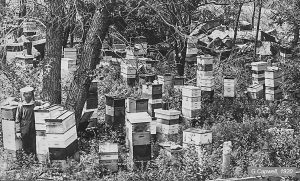
Figure 1. A Kansas beeyard in 1920. Note beekeeper in the lower left of the photo who is wearing a vintage Alexander veil and gauntlet gloves.
What Did this Mean for Apiaries?
It means that our apiaries, decades ago were weedier, and more unkempt by today’s standards. I cannot find information indicating that grazing animals were common methods for foliage management in pre-mower days. No doubt, cows, horses and sheep would occasionally knock over hives or scratch against them.
In the past, all apiary grass and weeds were cut manually requiring hot labor commitments. I’m old enough to remember life before string trimmers and herbicides. Everything was weedier then.
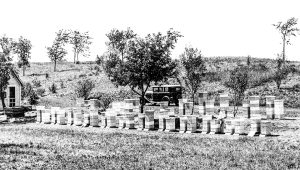
Figure 2. In 1922, in this Iowa beeyard, all grass was cut using manual methods. Gasoline mowers, of the day, were heavy and uncommon.
To Add to the Laborious Task
In years past, just as the present, protective bee gear was commonly worn when cutting and pruning near bee hives. Wearing protective equipment was just as clumsy now as it was years ago. The requirement to wear protective clothing has always made apiary weed control a hot, tiring job. Thankfully, modern protective equipment is better ventilated and more comfortable, but it is still hot work.
No-Mow May
Due to my early years of incessantly cutting grass, as a senior citizen, I am now a reluctant lawn mower. To the chagrin of my neighbors whose lawns are always neatly manicured, I only mow when I must. In this way, I avoid needless mowing sessions and my bees have access to the clover and dandelions in my lawn.
When I first heard of the concept, I readily embraced the notion of a “No-Mow May” in which we just give our lawns a month off from trimming. I quickly found out that a mow-less May lead me directly into a hellish June, with tall grass that frequently required raking after cutting. I had to go back to the lawn maintenance drawing board.
String Trimmers in the Apiary
I don’t remember the first time I used a string trimmer. With my mowing history that I touted before, that memory void seems strange to me. But I do know that a string trimmer became a necessary component of the equipment that always went with me to an outyard. String trimmers are now a common, if unexciting, beeyard management tool. What’s their story?
A Short History of String Trimmers
The history of string trimmers, also known as weed whackers, weed eaters or line trimmers, dates to the early 1970s. The concept of using a rotating nylon string to trim grass and weeds emerged as an alternative to traditional lawn mowers and manual cutting tools.
The concept of a rotating nylon line for cutting vegetation was developed in the late 1960s by George Ballas, a Houston-based entrepreneur. He got the idea while watching the revolving brushes at a car wash (I find this interesting. The common safety razor was envisioned after a visionary watched a woodworker use a common hand plane. The flail honey comb uncapper was conceptualized as another visionary watched the conveyor belt perform at a grocery store checkout. Shouldn’t we all be more observant?). In 1971, he received a patent for his invention, which consisted of a fishing reel with fishing line attached to the spool. Ballas’ invention was the foundation for the modern string trimmer.
In 1972, George Ballas partnered with Jim Goad, an engineer, to refine the design and create the first commercial string trimmer. They established the Weed Eater company and introduced the first gas-powered, handheld string trimmer to the market. This model quickly gained popularity due to its effectiveness in trimming grass and weeds in hard-to-reach areas.
In the late 1970s and early 1980s, electric string trimmers began to appear on the market. These models were lighter and quieter than their gas-powered counterparts, making them more appealing to homeowners with smaller yards.
Bees and Trimmers
No matter how useful power mowers and trimmers may be, on some mowing days, the bees seem to despise them. Most experienced beekeepers have seen this defensive behavior. In fact, common management recommendations warn the beekeeper to expect this attack. It is thought that the odors and vibrations from the mowers and trimmers agitate the bees.
In my own experience gained when trimming around hives, it seems that the bee response is greatest during Summer months when a nectar dearth has ended and the colonies are at full populations.
I have never used a battery-powered trimmer, but I am sure some of you have. I ask if you have noticed less of a response when using battery-powered mowers and trimmers? Does their quietness and lack of fumes have a more lenient effect on the colonies?
Beekeepers and Trimmers
At this moment, I have two, hand-held string trimmers. I have one modified with a cutting blade for heavy or tough growth. Brambles, such as multiflora rose, are a challenge for either type of cutting head.
Even though I frequently use them, I increasingly have issues with string trimmers. The evolving issue is that the older I become, my trimming sessions grow shorter and shorter. My shoulders ache. I get noise warnings from my Apple watch. I get hotter and hotter in the protective gear that I must wear. I simply can’t do the job the way I once could.
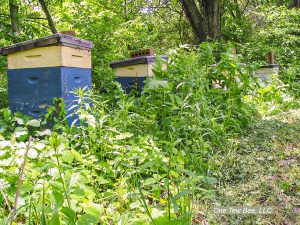
Figure 3. An apiary with uncontrolled grass growth.
Consequently, I have grown to dread the task more and more. All the while, the grass and weeds have continued to grow. Out of necessity, I developed a tolerant attitude of tall grasses and weeds in my apiary. I put my hives on firm hive stands that were twenty inches from the ground and I kept the entrance free of tall weeds. Even then, the grass and weeds in my beeyard continued to grow. My bees seemed unphased by the tall grass in the yards, but increasingly, it became apparent that this approach could not last. Why?
Two reasons that altered my laissez-faire system of yard maintenance evolved. The first reason was you, the reader of Bee Culture articles. Photos and videos that I captured in my apiary looked terrible. For instance, while I wanted to write about a new swarm that I just acquired, my photo of the new bee hive was marred by tall grass and the appearance of a generally unmanaged area. (If you have back issues of Bee Culture, you can readily see these photos.) I grew afraid that you, the reader, would not understand the bigger picture.
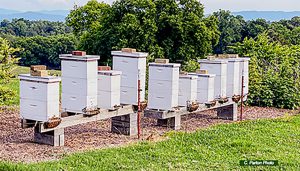
Figure 4. A manicured yard that uses herbicides, grazing animals and electric fencing to keeps foliage at bay. C. Parton Photo
Secondly, the tall weeds made it difficult for me walk while carrying a super of honey or other related bee equipment. Briars tugged at my suit. Tall grass made me stumble as I walked. Grass grew in and around my unused equipment. As with the No-Mow May scenario that I discussed earlier, I had to return to the drawing board. I was physically unable to trim my entire beeyard with a string trimmer and it was too much to ask of my 1972 Snapper push mower to systematically mow this tall grass.
A Heavy Duty, Walk-Behind Trimmer
I would occasionally see advertisements for various models of walk-behind trimmers. I asked around my circle of beekeeping friends, but no one had experience with these machines. I checked online. Yes, wheel kits were available for my string trimmers. In theory, I could modify my handheld trimmers to be mobile. Again, I asked around my circle of beekeeping friends, but no one had experience with these wheel kits either. All the while, the grass continued to grow. Would a trimmer on wheels allow me to work longer and more consistently?
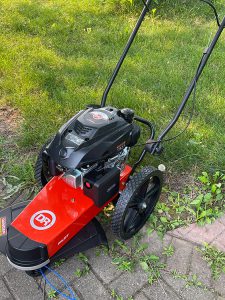
Figure 5. A walk-behind Cord Trimmer.
In mid-July, with apiary grass higher than my knees, I broke. This situation in my apiary was unacceptable and was never going to get better. I went to an equipment dealer to buy a wheel kit. They did not have one, but they did have a single walk-behind trimmer on the showroom floor. It was $400. I bought it on the spot. It uses four .175” spiral cutting cords and cuts a twenty-two-inch swatch. It cuts at five heights – from 1.5” to 3.5”. I set it to the highest setting. The machine fairly easily chewed through the tall weeds leaving me with a somewhat rough-looking finished job, but the weeds were readily cut down.
The nose on the machine does a reasonably good job of getting beneath my hive stands – not perfect – but reasonably good. The cords are not cost free and they do wear out, but the machine aggressively took out tall weeds. It worked.
The major drawback is that I must still push the machine through tall grass. That requires old fashioned perspiration, but it’s still easier than using a handheld string unit. Please know that I am not selling these units. I’m only looking for a yard maintenance remedy.
For beekeepers younger than or more physically fit than I am, a typical string trimmer would get the job done. As I have written in previous articles, I’m at a stage of my beekeeping where I try to put wheels on everything. String trimmers were no exception. I should also say that while the bees didn’t go crazy, I still needed to wear light protective gear when using the machine.
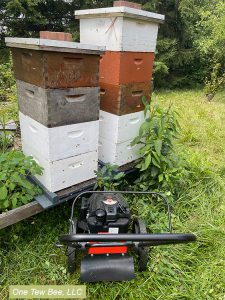
Figure 6. Weed whacking beneath hives.
Hot and Clumsy
This past July 2023 was the hottest July every recorded. Yet the grass kept growing. To keep the grass under control, grass-cutting beekeepers are hot, and clumsy, and are surrounded by irate bees. Can it get any worse? Yes, it can, at the same time, we are also using power mowing equipment. Occasionally, accidents happen. This is a beekeeper’s recent story.
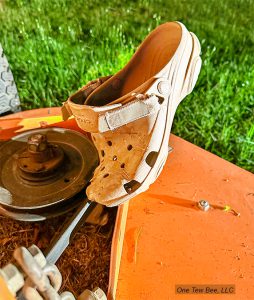
Figure 7. Accidents happen quickly. Attacking bees can be distracting. Many of us have a story.
I got home from work and my wife wanted to cut the grass but she’d never used that particular riding mower. I changed out of my work boots into my Crocs and pulled the mower out of the garage for her. I decided to make a couple passes by my bee hives so my wife wouldn’t get stung.
My bees have never bothered me before. On the first pass, I had hundreds of bees come after me. They were stinging me so much that I was fearful I might have an allergic reaction. I quickly decided to jump off the riding mower and make a run for the house. My foot got caught in the pulley and belt on the mower deck. My croc stayed lodged in the mower belt while I ran into the house. When I got inside and got all the bees off me, I realized how badly my foot was hurt.
I went to the Emergency Room where they said it had broken my toe and cut a tendon. It almost cut my toe off. I had 12 stitches and had to wear a Draco shoe that keeps the weight on my heel and off my toe until my broken toe can heal.
Mowing is Not Beekeeping
Every apiary mowing situation is different but presently, we have an abundance of diversified mowing devices. That selection of devices does not mean that mowing is not hot, demanding work. Don’t go crazy cutting grass and weeds, but when you do mow, I would suggest wearing heavy shoes and a ventilated bee suit with a veil that opens to allow for water sips. Have a lit smoker at the ready. Mowing is not beekeeping. Pace yourself.
Thank you.
I appreciate you reading and sending any comments that you may have. Your time is valuable. I know that.
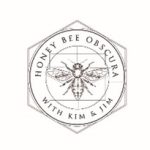 Dr. James E. Tew
Dr. James E. Tew
Emeritus Faculty, Entomology
The Ohio State University
tewbee2@gmail.com
Co-Host, Honey Bee
Obscura Podcast
www.honeybeeobscura.com






